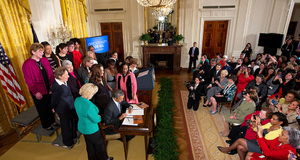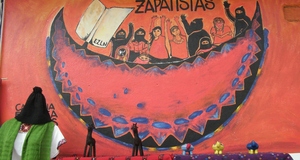The Political Returns of Philanthropy: The Case of Tammany Hall
By
2012, Vol. 4 No. 05 | pg. 1/2 | »
KEYWORDS:
New York’s 1827 mayoral election was the harbinger for a new era in politics. Tammany Hall—New York’s democratic political machine—suborned thousands of immigrants to vote for the pro-Tammany ticket. With cartloads of Irish in tow, ward leaders hurriedly moved from one polling place to the next allowing their passengers to cast as many as six votes apiece. In exchange for their vote the Irish received largesse such as food, clothing, or even cash. Back at New York City’s almshouse, inmates were also drawn into the democratic process at the behest of Tammany ward leaders. “The morning of the election was a busy time at the almshouse,” recalled an onlooker, “officers hurrying to and fro, getting together inmates of the establishment, clad in their new [clothes]… distributing to them tickets for grog, putting into their hands nice pieces of silver coin, that they might solace themselves after the arduous labor of depositing ballots.”1 In the nineteenth century America was ripe for corruption. The confluence of several drastic changes, including immigration, industrialization and a trend toward urbanization, had caused the number of needy citizens to grow exponentially. With limited or nonexistent government interest in caring for the increasing number of needy, entities like Tammany bore their salutary burden.2 As a consequence of filling this social service vacuum in the nineteenth century, Tammany generated social and political capital, as did others, such as the Women’s Christian Temperance Union (WCTU) who also reaped benefits from their charitable activities. To explain the success of Tammany Hall, scholar Erik L. McKitrick developed a conceptual framework which has been primarily examined by social historians. In Study of Corruption, McKitrick noted that diffusion and fragmentation of power, combined with public neediness, were the fundamental conditions necessary to support a political machine.3 Given the parity of social contexts within which these organizations thrived, their success can be aptly compared by applying McKitrick’s conceptual framework which was comprised of three latent functions: welfare, upward mobility and justice. The first integral component of Tammany’s voter mobilization strategy consisted of welfare in the form of charitable support—like that provided to almshouse inmates. Gifts of food, clothing and blankets were handed out to the needy for months before an election. Tammany would plan community social events where immigrants could be fed, and addressed in their own language regarding matters of political importance, often by prominent and influential members of their community. These leaders would have been elevated to a relative position of power by Tammany in order to extend influence over their ethnic cohorts. Sponsored events, such as these, fostered a sense of community among new immigrants with party officials at its center. Although Tammany philanthropy was most common near election time, ward leaders, appointed to tend to the needs of individual neighborhoods, were available to constituents on a regular basis. “[The] division leader must stay close to those who need him. He must be on the job to help them. The average division leader can always be found at a certain place—the corner cigar store, the drug store, or some such place. He goes there every night [so] when the voter wants him he knows where to find him,” reported ward leader William S. Vare in an interview with political scientist J.T. Slater.4 Ward leaders felt a personal responsibility to their constituents, as was demonstrable through additional assistance and personal favors they provided constituents that transcended the token aid given by the machine. While gifts like these were notably efficacious for Tammany politicians, such tactics were successful in winning constituent support because those on the receiving end were in great need of the resources, however small.Upward mobility for the disenfranchised—the second component identified by McKitrick—cannot be understated for Tammany’s voter mobilization efforts. Immigrants were appointed to a wide variety of civil service jobs, always through neighborhood Tammany officials, like the ward leader. After the successful election of a Tammany mayoral candidate, each district was allotted a quota of jobs to fill, all of which were paid positions. Police, fireman and the like were among the most common positions to which the Irish, and less frequently German, immigrants were assigned. In fact, by 1855, more than one third of New York’s significant police force was not native born. That same year, police chief George W. Matsell reported that that out of 1,149 officers, 431 were immigrants, 305 of whom were Irish.5 As Tammany became heavily involved in construction grafts, resulting job appointments also grew, thus increasing opportunities for Tammany’s constituents to be upwardly mobile. In terms of justice, the New York City government was notoriously corrupt during Tammany’s reign. To citizens, corruption was most palpable at the ground level. For instance, Police were know for shaking down criminal and victims alike, receiving payment from the former to avoided capture and charging the fees to the later for basic services such as hunting down stolen property. Eventually, this behavior led residence of New York’s Five Points neighborhood to seek direct intervention from Tammany mayor, Fernando Wood.6 When McKitrick proposed his model to explain political machines and the great measure of success that they enjoyed, he postulated the significance of justice in relation to businessmen.7 According to McKitrick’s conception, machines served this function by protecting businesses from one another, expediting projects and helping business owners to understand often conflicting local laws.8 However, critical examination reveals that the use of justice extended to every day citizens. Even early in in the twentieth century, after attritional reform impulses had significantly reduced police corruption, Tammany politicians continued to take an active role in the administration of justice in order to curry favor with voters. In 1909, Tammany politician, “Big” Tim Sullivan, a first generation Irish immigrant, employed New York’s police force to raid the clubhouse of an Irish gang who had been harassing newly immigrated Orthodox Jews. Sullivan had the gang permanently removed from the premises, subsequently renting the gags clubhouse to their victims for use as a synagogue, thus demonstrating the importance that Justice played in endearing Tammany to immigrant voters of all stripes.9 For the WCTU, welfare was an equally important factor in their rise to eminence. For Example, in 1889, the women of the Chicago Union operated a mission that sheltered four thousand homeless and a free medical dispensary, which cared for sixteen hundred patients. The Chicago mission also included a temporary lodging house for destitute men, two daycare centers and two Sunday schools.10 As the pauper citizens inhabiting urban areas continued to increase, women, like machines, were able to capitalize on the lack of an existing, systematized relief effort. Although individual city chapters of the WCTU were autonomous, allowing each group to implement unique welfare programs, this element of Union’s activities marked a consistency that was present in chapters throughout the nation. Unlike the use of charity by political machines, the WCTUs prize for their philanthropic activities was not the support of those they served. Rather, it was the societal approval they received not only in spite, but because of their engagement in activities outside the home that had heretofore been considered unladylike. Despite the seemingly benevolent intentions of the welfare employed by the WCTU, women were not above using charity to directly influence their political goals. The New Orleans chapter reportedly administered a dinner service for destitute boys. Out of the 300–400 boys that attended this event, women in the Union bragged that they were able to illicit more than 100 pledges of temperance.11 This tactic contained a notable similarity with the community events sponsored by Tammany. Due to the relative lack of economic and political power wielded by women in the nineteenth century, the WCTU may not have provided financial upward mobility to the same degree as Tammany. Yet despite this apparent disparity, social mobility for the disenfranchised was likewise critical for the WTCU. Instead of financial mobility, women provided upward social mobility to the populations they worked with by instructing them on acceptable societal and religious practices such as, the use of proper hygiene, child rearing and correct observation of religious traditions. As such, families who received this type of instruction were systematically taught to adopt the social customs of the American upper middle class, thereby allowing the immigrant poor to be upwardly mobile through the adoption of whiteness.Continued on Next Page » Suggested Reading from Inquiries Journal
Inquiries Journal provides undergraduate and graduate students around the world a platform for the wide dissemination of academic work over a range of core disciplines. Representing the work of students from hundreds of institutions around the globe, Inquiries Journal's large database of academic articles is completely free. Learn more | Blog | Submit Latest in Political Science |
















